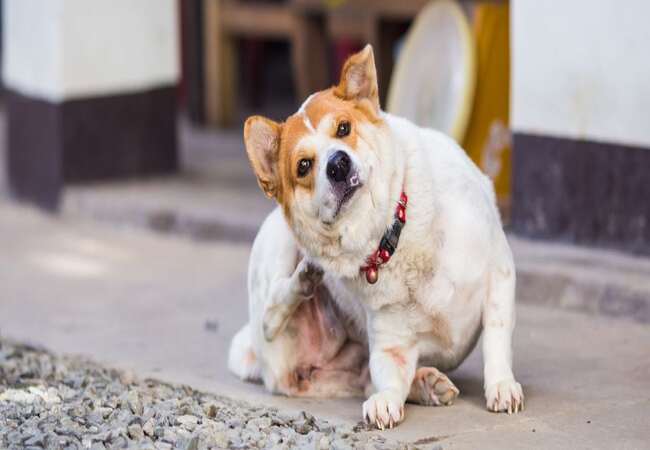Vet’s 2025 Guide to Canine Seborrhea Diagnosis, Treatment & Skin Care 🩺

In this article
Vet’s 2025 Guide to Canine Seborrhea Diagnosis, Treatment & Skin Care 🩺
By Dr. Duncan Houston BVSc
💡 What Is Seborrhea?
Seborrhea, also called seborrheic dermatitis, is a skin disorder marked by abnormal skin cell turnover and/or excessive sebum production. Dogs may show dry flakes (seborrhea sicca) or oily, greasy skin (seborrhea oleosa) — often mixed.
🔍 Types: Primary vs Secondary
- Primary seborrhea is genetic and becomes apparent by 2 years of age. Common breeds include Cocker Spaniels, Westies, Bassets, Dachshunds, Labs, Goldens, and GSDs.
- Secondary seborrhea is far more common, resulting from underlying conditions like allergies, endocrine disorders (like Cushing’s or hypothyroidism), parasites, mites, yeast/bacterial infections, poor diet, environmental factors, or obesity.
🚩 Clinical Signs
- Visible flakes or grease on coat, bedding, furniture.
- Greasy, shiny coat with unpleasant odor—especially with oleosa type.
- Dry, dandruff-like scaling and possible hyperpigmentation.
- Usually not itchy in primary form—but can become pruritic if secondary infections set in.
- May have hair loss, redness, pustules, or odor if infection is present.
🧪 Diagnosis Process
- History & physical: onset age, breed, itch level, coat changes.
- Skin scrapings/cytology: to rule out parasites (mites, fleas) or infections (bacterial, yeast).
- Bloodwork: CBC/chemistry to check hormones (thyroid, adrenal) or metabolic issues.
- Allergy testing or food trial if indicated by history.
- Skin biopsy if diagnosis unclear or primary form suspected.
🩺 Treatment & Management
1. Medicated Baths & Topical Care
- Shampoos with sulfur-salicylic acid, benzoyl peroxide, or antioxidants to manage scale, sebum, odor.
- Degreasing followed by moisturizing shampoos for oleosa type.
- Topical leave-on treatments (creams, mousses) to help normalize skin barrier.
- Bath frequency: weekly to twice weekly initially, taper to maintenance as signs resolve.
2. Treat Underlying Issues
- Parasites: flea, tick, or mite prevention/support if applicable.
- Infections: topical or oral antimicrobials for bacterial or yeast overgrowth.
- Hormonal/endocrine: treat hypothyroidism, Cushing’s disease per diagnosis.
- Allergies/immune: food trials, immunotherapy or corticosteroids if needed.
3. Nutritional & Supplement Support
- Omega-3 & 6 fatty acids: to enhance skin barrier and reduce inflammation.
- Vitamin A or retinoids: helpful in primary forms.
- Balanced, high-quality diet: ensures proper skin and coat health.
4. Monitoring & Follow-up
- Frequent rechecks early (every 4–6 weeks), then space out once stable.
- Adjust bath frequency and medications based on skin condition.
- Reassess if flares reoccur or new symptoms appear.
📈 Prognosis
- Primary form is lifelong but manageable. With maintenance care, most dogs remain comfortable and coat appears healthy.
- Secondary form resolves once underlying issues are treated; maintenance baths support long-term skin health.
- Excellent quality of life possible with consistent treatment and monitoring.
🚫 Prevention Strategies
- Maintain routine parasite prevention.
- Regular grooming and bathing with mild products.
- High-quality nutrition and appropriate supplements.
- Prompt vet evaluation for chronic skin issues or unexplained coat changes.
🏡 Ask A Vet App Integration
- 🗓️ Reminders: bath days, supplement dosing, recheck appointments.
- 📸 Photo tracking: coat shine, scaling levels, visible improvement.
- 📊 Logs: itchiness scores, odor notes, greasiness levels.
- 🔔 Alerts: flare-ups, secondary infection signs (redness, odor), hair loss.
- 📚 Tutorials: bathing techniques, supplement guidelines, when to test.
🔑 Key Takeaways
- Seborrhea involves flaky or greasy skin due to keratin or sebum dysfunction.
- Differentiate primary (genetic) and secondary forms (due to disease).
- Diagnosis involves clinical exam, tests, and possibly biopsy.
- Management combines baths, treat underlying causes, nutrition, and supplements.
- Ask A Vet app empowers pet parents with structure, monitoring, and support.
🩺 Final Thoughts ❤️
In 2025, seborrhea—even lifelong primary forms—can be effectively controlled with targeted topical care, nutrition, and treatment of underlying conditions. When paired with the Ask A Vet app’s reminders, photo tracking, education, and remote veterinary support, pet owners can keep their dogs comfortable, fresh-smelling, and healthy—no matter the coat type. 🐾✨
Visit AskAVet.com and download the Ask A Vet app to set bath schedules, track skin progress, log supplements and meds, schedule vet check‑ins, and connect with expert care from anywhere. 📲






